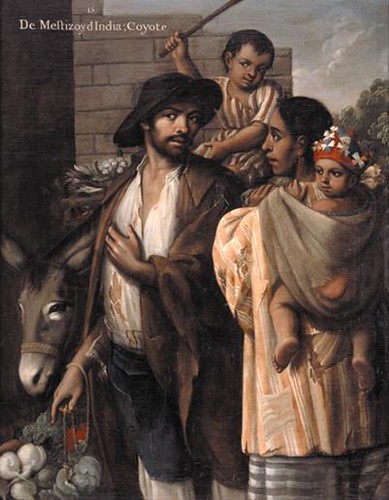Honor in the Past: The Case of Mexico
Mexican colonial society was highly hierarchical. Those at the top of society judged those below them by race and class and assumed that they lacked honor. The lack of external accouterments that marked high status denoted plebeians as low in rank and honor. Elite Mexicans often used external indications such as phenotype, clothes, professions, and bodily attitudes to classify people. In the late eighteenth century, these attitudes were expressed in an artistic movement called casta paintings. These paintings tried to codify the complexities of racial mixture but, in addition, they expressed ideas about social gradations and honor. Figure 1 shows the depiction of a lower class couple. Note their simple clothes that are patched and ripped. The woman is wearing a huipil—a dress associated with indigenous women. The caption identifies her as indigenous but her clothing and her hairstyle of tightly pulled-back braids all point to this identity. The painting encapsulates elite Mexican attitudes about honor by associating the couple with a profession of selling vegetables (which would have been considered lowly and dishonorable) and the use of a mule or donkey rather than a horse. This painting is a good indication of how elite Mexicans viewed plebeians and their lack of honor. It provides an iconology to classify people as low caste and without honor.

But, plebeians such as the family represented in figure 1 did not necessarily accept their lack of honor. Without titles of nobility and certificates attesting to bloodlines, it was more complicated, but plebeian men and women used other methods to assert their place in society and defend their honor (Lipsett-Rivera, in press). Although the way that elite authors codified honor in books was simple, the manner in which people lived it was more complex. Historians can go beyond these definitions and detect this complexity by reading documents that illustrate the way in which people, who technically should not have had claim to honor, asserted their honor. They self-identified as honorable persons because they were born to families that, although plebeian, were of high status within their own social networks (Cope, 1994, Gonzalbo Aizpuru, 2009). What is clear, however, is that both within elite circles and among plebeians there were gradations of honor as associated with status. This is one of the contributions that historians can make to the study of honor by separating out how people lived and expressed their honor through their actions rather than their words.
The other element of honor, honra, was associated with virtue. This quality was more egalitarian, as anyone could aspire to live a clean life, free of vices, and demonstrating valor. Yet, it was easier for those of the upper classes to assert their good morals and bravery because it was assumed that they were up-standing and courageous. Plebeians did, however, affirm their good character in some formulaic manners (Lipsett-Rivera, 1998). For example, those born to married couples made a point to say so, because they believed it served as evidence of their legitimacy. They pointed the finger at others who engaged in amorous affairs, in order to emphasize their chaste lives. They wore decent clothes while others went about in revealing rags. They were honest in their commercial dealings. For both the upper and lower classes, it helped to be born into a family with a good reputation and whose level of wealth allowed a type of insulation against temptation, but also, against suspicion. The biggest threats to honor by virtue were rumors and gossip. As such, people reacted strongly to such accusations. The two elements—status and virtue—were very much linked because it was hard to maintain social position while breaking moral codes. At the same time, elite Mexicans assumed that those born without status could not really be virtuous.
One of the lessons that can be learned from history is that, despite any claims to higher standards in the past, people tended to break conventions and rules in the past as they do in the present. Thus, even though some chroniclers may exalt the virtues of ancestors, people did not live strictly within the guidelines set out within codes of honor. While all levels of society asserted their rights to honor and acted as if they possessed this attribute, their actions did not always correspond. Mexicans valued their honor, however, and struggled to defend it. Honor was a fragile quality; it could be lost if other people did not recognize it. Therefore, it was important to defend against any breaches of this social code. Because of this fact, Mexicans attacked those who doubted their valor, who accused them of moral failures, and who would bring disgrace into the bosom of their family.

